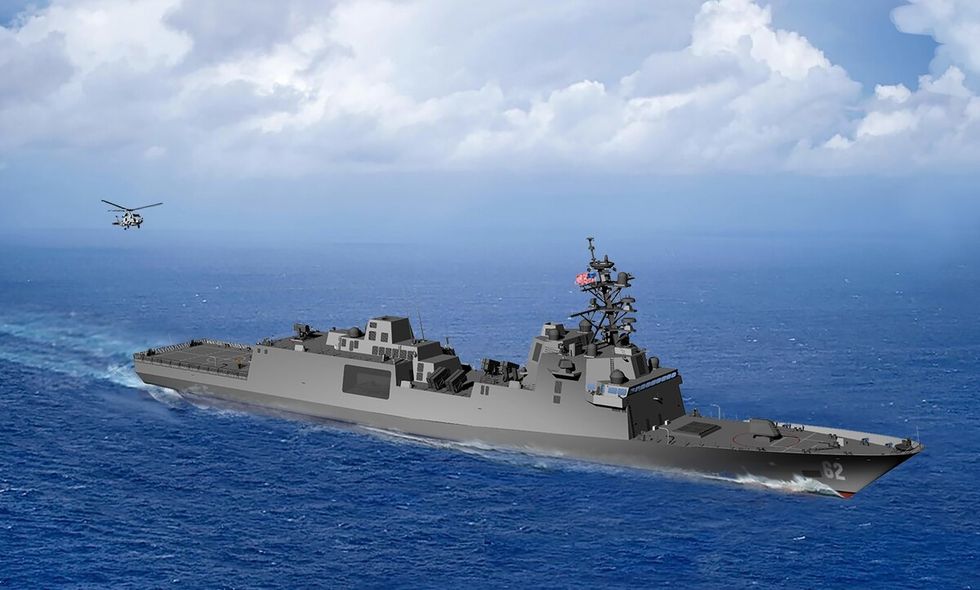
Artist rendering of the final Constellation-class design
Jan 14, 2021
U.S. Navy
The U.S. Navy just issued an update on its Constellation-class frigate program.
The guided missile frigates will enter the fleet starting in 2026.
The multi-mission ships will also eventually displace the failed Littoral Combat Ship program.
The U.S. Navy has issued a briefing on a new fleet of frigates set to enter service in the mid-2020s. The Constellation-class frigates, based on an Italian design, give the Navy the opportunity to bulk up with relatively inexpensive ships and shake off decades of bad shipbuilding choices.
The Constellation-class frigates are named after one of the first six warships to join the Navy. The second ship in the class, Congress, is named after another one of the original six. (One of the ships, USS Constitution, is still afloat and technically still part of the Navy.)
The Constellation ships are multi-mission ships that are capable of anti-submarine warfare, anti-surface warfare (anti-ship and land attack), and anti-air warfare (anti-aircraft, anti-missile, and now anti-drone) missions.
Italian shipbuilder Fincantieri based the design on the Italian FREMM-class frigates and heavily modified it to use American sensors and weapons. The frigates will be built at Marinette Marine Corporation in Wisconsin, which means they will initially be freshwater ships that must travel through the Great Lakes and St. Lawrence Seaway to enter the Atlantic Ocean.
Constellation and her sister ships will be 496 feet long, displace 7,200 tons in the water fully loaded, and sail with a 200-person crew. The eyes and ears of the ship will consist of the AN/SPY-6 radar system for detecting aerial threats and the AN/SQQ-89(V)16 sonar system for spotting subsurface threats. Both are capable of not only defending the ship, but a larger, multi-ship task force as a whole, such as a carrier strike group or amphibious expeditionary strike group.
The new ships will be heavily armed for their size, packing both guns and missiles. The ships will be armed with an Mk. 110 57-millimeter rapid fire deck gun that can engage ships, aircraft, drones, and even incoming missiles. The frigates will also include an Mk. 49 Rolling Airframe Missile (RAM) point defense missile system for downing aerial threats at short range. A hangar and flight deck will service a MH-60R Seahawk helicopter and uncrewed aerial vehicles.
Each Constellation-class frigate will carry 16 Naval Strike Missiles—twice as many dedicated anti-ship missiles as any other surface ship.
The most powerful part of the Constellation’s armament, however, is the ship’s 32 Mk. 41 vertical launch system silos.
Each silo can carry one vertical launch anti-submarine rocket, one SM-2 or SM-6 surface-to-air missile, or one Tomahawk land attack cruise missile. The silos can even conceivably carry the Navy’s larger Long Range Anti-Ship Missile, or four smaller Evolved Sea Sparrow short-range air defense missiles.
The Navy can mix and match missiles to fit a ship’s mission. For example, a ship operating as part of a supply convoy could load up on anti-submarine rockets, while a frigate supporting an amphibious landing could optimize its missile load to defend lightly armed transports and bombard enemy defenses with Tomahawk missiles.
The Constellation-class frigates are the Navy’s chance to bulk up its ship fleet in a relatively inexpensive way. The Navy wants to get from its current fleet of 297 ships to 355 or even 400 ships, but the extreme cost of today’s warships (and an aging ship fleet) are making it a “three steps forward, two steps back” process. Buying cheap, capable ships like Constellation is one way to get to the magic 355 number.
The new frigate class is also the Navy’s chance to show it can actually make smart choices when it comes to warships.
The last two decades were littered with poor shipbuilding decisions. The Zumwalt-class destroyers were too expensive and eventually shrunk from 32 ships to just three. The Littoral Combat Ships, frigate-sized vessels designed to operate in coastal regions, suffer from technical issues, and the swappable “mission modules” designed to arm and equip them are largely unavailable after more than a decade of research and development. And the USS Gerald R. Ford, the Navy’s first new carrier design in 40 years, suffers from cost overruns and poor readiness as a result of being loaded with unproven technology.
The Navy will initially build 20 Constellation ships. If the design is successful, the service will almost certainly order more—perhaps as many as 50 or more frigates in all.